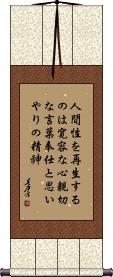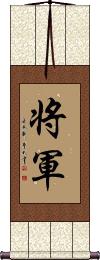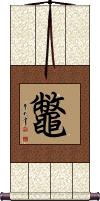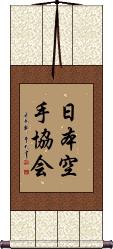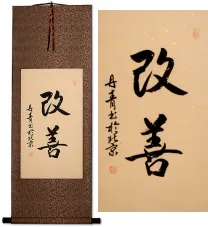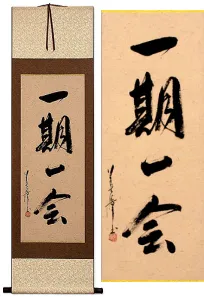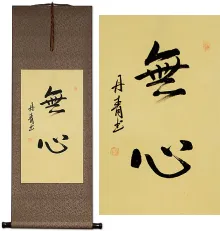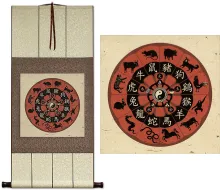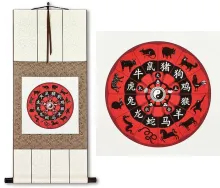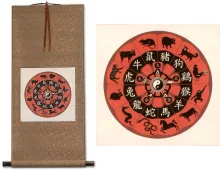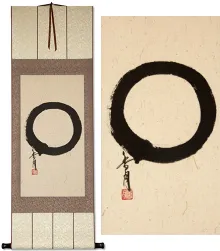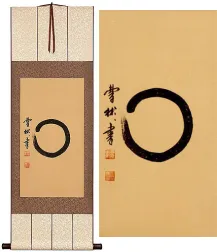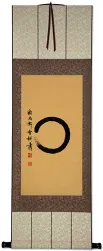Many custom options...
And formats...

Not what you want?
Try other similar-meaning words, fewer words, or just one word.
Japanese Symbols in Japanese...
Buy a Japanese Symbols calligraphy wall scroll here!
Personalize your custom “Japanese Symbols” project by clicking the button next to your favorite “Japanese Symbols” title below...
See also: Selections of just Japanese Kanji Calligraphy
Switched to secondary search mode due to lack of results using primary.
These secondary results may not be very accurate. Try a different but similar meaning word or phrase for better results. Or...
Look up Japanese Symbols in my Japanese Kanji & Chinese Character Dictionary(My dictionary is a different system then the calligraphy search you just tried)
If you want a special phrase, word, title, name, or proverb, feel free to contact me, and I will translate your custom calligraphy idea for you.
Triple Truth of Japanese Buddhism
人間性を再生するのは寛容な心親切な言葉奉仕と思いやりの精神 is known as the Triple Truth of Buddhism in Japanese.
The Buddha ordered that all should know this triple truth...
A generous heart, kind speech, and a life of service and compassion are the things that renew humanity.
That is the English translation most commonly used for this Japanese Buddhist phrase. You might have seen this on a coffee cup or tee shirt.
Note: Because this selection contains some special Japanese Hiragana characters, it should be written by a Japanese calligrapher.
Enso - Japanese Zen Circle
〇 is the famous Enso symbol, which you will see widely used by Japanese Zen Buddhists.
In a twist, I am starting to see Enso used more and more by Chinese Buddhists.
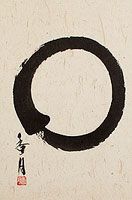
Here is the typical appearance of Enso artwork by Japanese calligrapher Kougetsu.
Enso is not a Japanese Kanji character. It falls more into the category of a symbol. There is some debate, but many consider Enso to be a religious symbol.
Some call this “The Circle of Enlightenment.” Others call it the “Infinity Circle.” If you actually took the meanings of the two Kanji (円相) that make up the word “En-so,” you could read it as “Mutual Circle” or “Circle of Togetherness.” I think the Enso symbol can simply mean different things to different people. Therefore, you should let it have the meaning that you perceive.
The appearance of your Enso will be determined by the artist's personal style, feeling, mood, etc.
Shogun / Japanese General
将軍 or Shogun, in the simplest definition, is a General, but you could also use words such as commander, lord, overlord, highest ranking, or commanding officer.
The title “Shogun” has held some slightly ambiguous meanings at times in Japanese history.
In the west, when someone mentions “Shogun,” we may be filled with thoughts of gallant warriors. Some might even think of the TV mini-series with Richard Chamberlain. Often westerners use the words, Samurai and Shogun interchangeably, but that's really not technically correct. In the case of the Samurai, the Shogun was a designated (by the emperor) leader of a gild of Samurai. In this context, the Shogun was a Samurai lord. Or effectively, a commanding officer of a company of Samurai - to put it in modern military terms.
Sometimes a Shogun was a general; other times, he was the leader of a military government in Japan - but not a front-line warrior like a Samurai.
Variants of the same characters are used in China for the rank and title of a General of the People's Liberation Army (and the same term and characters have been used for the last 2200 years since the Qin Dynasty).
Japanese Snapping Turtle / Chinese Soft Shell Turtle
鼈 refers to a species of turtle.
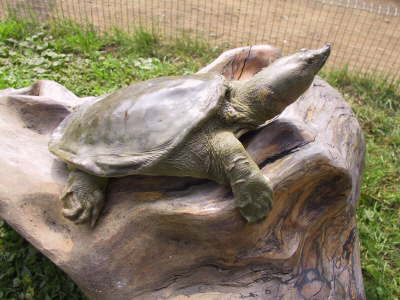
鼈 is Trionyx Sinensis.
鼈 refers to different turtles in different languages. See individual language notes below:
Japanese: 鼈 means “snapping turtle” or “mud turtle.” But rarely used as a single Kanji like this in Japanese.
Chinese: 鼈 means soft-shelled turtle. A specific species, Trionyx Sinensis is native to Asia.
In China, this species is related to the “wang ba,” a soft-shelled turtle sometimes known in English as a banjo turtle (due to its long neck, and general shape). Unfortunately, there is a word, “wang ba dan” which means the egg of this species of turtle. That term has come to mean “bastard” in Chinese (a turtle hatches from an abandoned egg, and does not know who his mother or father is). 鼈 is not a good selection for a wall scroll if your audience is Chinese.
In Korean, this character can be pronounced (though most Koreans would have to look it up in a dictionary). It has not been in common use in Korea for at least a few hundred years.
General notes: You may notice that the bottom half of this character is the same as some other turtle-related titles. That bottom half is actually an ancient character that means “toad.” ![]() Though not seen in this way today, most turtle-related characters hold the meaning of “a toad with a shell” in their ancient origin. That toad character is rarely used alone anymore but you can see what it looks like in the image to the right.
Though not seen in this way today, most turtle-related characters hold the meaning of “a toad with a shell” in their ancient origin. That toad character is rarely used alone anymore but you can see what it looks like in the image to the right.
Japanese Snapping Turtle
Japanese Karate Association
This in-stock artwork might be what you are looking for, and ships right away...
Gallery Price: $340.00
Your Price: $188.77
Gallery Price: $79.00
Your Price: $43.88
Gallery Price: $36.00
Starting at: $20.00
Gallery Price: $200.00
Your Price: $122.88
Not the results for japanese symbols that you were looking for?
Below are some entries from our dictionary that may match your japanese symbols search...
| Characters If shown, 2nd row is Simp. Chinese |
Pronunciation Romanization |
Simple Dictionary Definition |
加点 see styles |
katen かてん |
(n,vs,vt,vi) (1) (ant: 減点・1) adding points; (n,vs,vt,vi) (2) addition of marks and symbols to a classical Chinese text to aid reading in Japanese |
圏点 see styles |
kenten けんてん |
(symbols such as o and `) (See 傍点・1) emphasis mark (used in Japanese text in a way similar to underlining) |
大日 see styles |
dà rì da4 ri4 ta jih dainichi だいにち |
Mahavairocana (Tathagata); Great Sun; Supreme Buddha of Sino-Japanese esoteric Buddhism; (place-name, surname) Dainichi Vairocana, or Mahāvairocana 大日如來; 遍照如來; 摩訶毘盧遮那; 毘盧遮那; 大日覺王 The sun, "shining everywhere" The chief object of worship of the Shingon sect in Japan, "represented by the gigantic image in the temple at Nara." (Eliot.) There he is known as Dai-nichi-nyorai. He is counted as the first, and according to some, the origin of the five celestial Buddhas (dhyāni-buddhas, or jinas). He dwells quiescent in Arūpa-dhātu, the Heaven beyond form, and is the essence of wisdom (bodhi) and of absolute purity. Samantabhadra 普賢 is his dhyāni-bodhisattva. The 大日經 "teaches that Vairocana is the whole world, which is divided into Garbhadhātu (material) and Vajradhātu (indestructible), the two together forming Dharmadhātu. The manifestations of Vairocana's body to himself―that is, Buddhas and Bodhisattvas ―are represented symbolically by diagrams of several circles ". Eliot. In the 金剛界 or vajradhātu maṇḍala he is the center of the five groups. In the 胎藏界 or Garbhadhātu he is the center of the eight-leaf (lotus) court. His appearance, symbols, esoteric word, differ according to the two above distinctions. Generally he is considered as an embodiment of the Truth 法, both in the sense of dharmakāya 法身 and dharmaratna 法寳. Some hold Vairocana to be the dharmakāya of Śākyamuni 大日與釋迦同一佛 but the esoteric school denies this identity. Also known as 最高顯廣眼藏如來, the Tathagata who, in the highest, reveals the far-reaching treasure of his eye, i.e. the sun. 大日大聖不動明王 is described as one of his transformations. Also, a śramaņa of Kashmir (contemporary of Padma-saṃbhava); he is credited with introducing Buddhism into Khotan and being an incarnation of Mañjuśrī; the king Vijaya Saṃbhava built a monastery for him. |
仮名文字 see styles |
kanamoji かなもじ |
the Japanese syllabary symbols |
大和文字 see styles |
yamatomoji やまともじ |
(See 唐文字) Japanese syllabary symbols; kana |
三種の神器 see styles |
sanshunojingi さんしゅのじんぎ |
(exp,n) (1) the Three Sacred Treasures (Mirror, Sword and Jewels); three sacred emblems of sovereign rule; the three divine symbols of the Japanese imperial throne; (exp,n) (2) (idiom) (colloquialism) (set of) three status symbols; three necessities |
The following table may be helpful for those studying Chinese or Japanese...
| Title | Characters | Romaji (Romanized Japanese) | Various forms of Romanized Chinese | |
| Triple Truth of Japanese Buddhism | 人間性を再生するのは寛容な心親切な言葉奉仕と思いやりの精神 | ningensei o saisei suruno wa kanyou na kokoro shinsetsu na kotoba houshi to omoi yari no seishin ningensei o saisei suruno wa kanyo na kokoro shinsetsu na kotoba hoshi to omoi yari no seishin | ||
| Enso - Japanese Zen Circle | 〇 | en sou / ensou / en so | ||
| Shogun Japanese General | 將軍 将军 | shougun / shogun | jiāng jūn jiang1 jun1 jiang jun jiangjun | chiang chün chiangchün |
| Japanese Snapping Turtle Chinese Soft Shell Turtle | 鼈 | suppon / supon | biē / bie1 / bie | pieh |
| Japanese Snapping Turtle | 噛み付き亀 | ka mi tsu ki game kamitsukigame | ||
| Japanese Karate Association | 日本空手協會 日本空手協会 | ni hon kara te kyou kai nihonkaratekyoukai ni hon kara te kyo kai | rì běn kōng shǒu xié huì ri4 ben3 kong1 shou3 xie2 hui4 ri ben kong shou xie hui ribenkongshouxiehui | jih pen k`ung shou hsieh hui jihpenkungshouhsiehhui jih pen kung shou hsieh hui |
| In some entries above you will see that characters have different versions above and below a line. In these cases, the characters above the line are Traditional Chinese, while the ones below are Simplified Chinese. | ||||
Successful Chinese Character and Japanese Kanji calligraphy searches within the last few hours...
